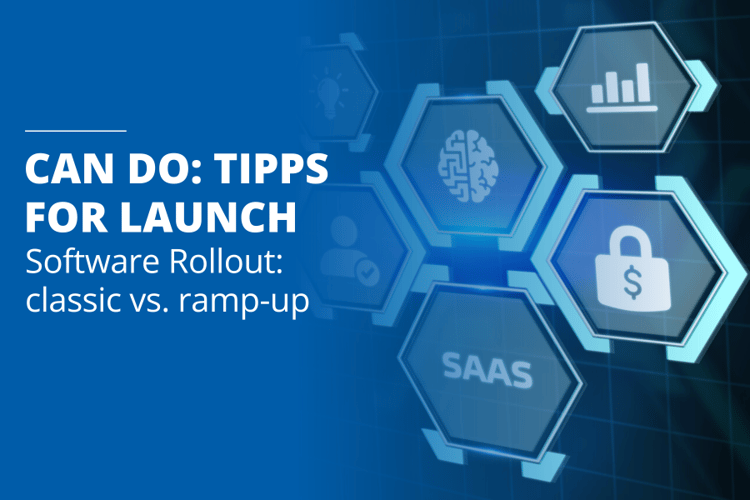Your IT can't wait any longer to install the new version of an enterprise software? Are you planning the launch of another program? When it comes to digitalization, you finally want to get things off the ground faster? Then you should rethink the decision-making and implementation processes in your company! In this short article, our CEO Thomas Schlereth explains what matters. And why a ramp-up makes so much sense.
A new software is needed!
One of the main activities of IT departments in companies is the introduction of new or additional business software. This can be, for example, a commercial system for order management, a new document management system, a complete ERP system or even a project and resource management system.
This article describes two procedures, how companies proceed with such a "rollout", which advantages and disadvantages the two procedures have and why which procedure is used at all.
Why does a company introduce a new software?
Since the 1950s, companies have been using computer programs to make processes more efficient. Initially, it was mainly public authorities and financial companies that used customized solutions; today, on the other hand, standard solutions are mainly in use. The classic procedure for introducing a standard solution is similar to the procedure for developing a customized solution. Although the first standard software for companies came onto the German market as early as the 1970s and SAP's R/3® was introduced in 1992, little has changed in the procedure to date.
The classic procedure of introducing an enterprise software in a company
Classic project management methods are often referred to as "waterfall" projects. Here, projects are divided into phases that are carried out one after the other. The classic process that precedes a software launch is very similar; the phases in the launch of a new product are:
- Requirements definition,
- Product selection,
- Customization and integration in the company,
- Activation for users and, if necessary
- Optimization phase.
Each party involved formulates individual requirements and wishes, whereupon various suppliers of standard products are sifted through. A long decision-making phase follows before the rollout finally begins. At the end, users are trained and supported. However, it often turns out that this method does not work. There are several reasons for this, e.g. the company does not have the necessary know-how or the number of people involved is too large. The bottom line is that the company does not work closely enough with the vendor, and disruptive changes occur during the project. In the process, the parties involved are often only focused on the point that is most important to them: signing the purchase agreement.
Introduction of enterprise software according to the agile ramp-up method
The ramp-up procedure accommodates the wishes of the individual users: The software is quickly deployed and evaluated by the users. Ramp-up turns the waterfall process around and prioritizes the technical evaluation over other internal decision paths. The classic waterfall approach designs theoretical sample solutions that are not necessarily suitable for end users. The ramp-up process prioritizes benefits to the business and is relevant in a rapidly evolving technology world.
Procedure of the Ramp-Up Method using the example of the project and resource management solution Can Do
A company recognizes weaknesses in project and resource management and looks for solutions. Various vendors present their solutions, but without typical sales presentations. Instead, consultants and users communicate directly. The provider makes the software available in the cloud and is compensated for this. Together, an initial use case is defined and implemented. An overview of ongoing projects is created. Further use cases are defined and implemented iteratively. The solution possibly becomes established in further departments and finally in the company - or is discontinued.
Consideration of the Ramp-Up Method
One method of successfully introducing a software solution is to offer it as a monthly rental for a department. This eliminates a complicated investment process and only a few people are involved. The solution is deployed in the cloud and can be tested immediately by the end users. The solution has to prove itself every month, and the decision makers are the users themselves. Know-how is created at the customer through gradual deployment and optimization. Other departments and IT systems are only integrated if there is a visible benefit for the users.
Summarized comparison of the methods
Both methods have advantages and disadvantages, but the trend is toward the ramp-up method. Management should promote departments in this method to increase acceptance and reduce costs. The ramp-up method should generally be considered for every new acquisition of an IT solution.
This text is a summary of an article written by Thomas Schlereth for the Can Do Knowledge Base. The detailed version with further results and findings is available via this link.
Jetzt anmelden - Can Do Newsletter
As a member of the management board, Thomas is responsible for the operative management of the development including conception, design and further development of the software. He also advises customers on best practices and supports the roll-out.
Why Do Projects Fail? 5 Common Reasons - And How to Avoid Them
Projects are often complex, and even with the best intentions and a competent team, success can elude us. But why do so...
Cost-Cutting - Increasing Efficiency Without Additional Resources
Cost-cutting is currently at the top of the agenda for many companies. In the face of economic uncertainty and rising...
.png?width=200&height=80&name=CanDo%20Logo%20transparent%20(500%20x%20200%20px).png)

